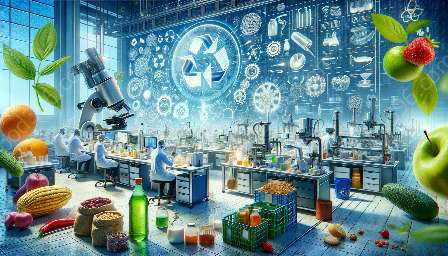Food storage and transportation are crucial aspects of the food industry, encompassing various scientific and technological considerations that influence the quality and safety of food products. In this comprehensive topic cluster, we will delve into the principles and advancements in food science and technology related to food storage and transportation, exploring their impact on the food and drink industry.
The Importance of Food Storage and Transportation
Effective food storage and transportation are essential for maintaining the quality, nutritional value, and safety of food products from the point of production to consumption. They play a vital role in preventing food waste, preserving freshness, and ensuring that consumers receive safe and high-quality food.
Principles of Food Storage
Food storage involves the preservation of perishable food items through various methods such as refrigeration, freezing, canning, and dehydration. These methods aim to inhibit microbial growth, enzymatic activity, and oxidative reactions that can lead to spoilage and deterioration of food quality.
Refrigeration and Cold Chain Management
Refrigeration is a fundamental aspect of food storage, as it slows down the rate of bacterial growth and enzymatic reactions in perishable foods. Cold chain management, which ensures that food products are maintained at the optimal temperature throughout the supply chain, is critical for preserving the freshness and safety of perishable goods.
Freezing and Cryogenic Storage
Freezing is a widely used method for preserving food by inhibiting microbial growth and enzymatic activity. Cryogenic storage, which involves ultra-low temperatures using liquid nitrogen or carbon dioxide, is employed for preserving certain food products, such as meats and processed foods, to extend their shelf life.
Canning and Aseptic Processing
Canning and aseptic processing involve the sterilization of food products and packaging to create a stable, long-lasting environment that prevents microbial contamination. These methods are commonly used for preserving fruits, vegetables, and beverages.
Dehydration and Vacuum Packaging
Dehydration removes moisture from food, inhibiting the growth of spoilage microorganisms. Vacuum packaging further extends the shelf life of dehydrated foods by creating an oxygen-free environment that prevents oxidative degradation.
Challenges and Innovations in Food Transportation
Food transportation is a critical link in the supply chain, ensuring that food products reach their destination safely and in optimal condition. However, it poses challenges related to temperature control, packaging integrity, and efficient logistics. Advancements in food science and technology have led to innovative solutions to address these challenges.
Temperature-Controlled Logistics
Temperature-controlled transportation systems, such as refrigerated trucks and containers, are designed to maintain specific temperature ranges during transit, preventing fluctuations that can compromise food quality. Advanced monitoring and control technologies ensure precise temperature management throughout the transportation process.
Smart Packaging and Sensors
Smart packaging technologies incorporate sensors and indicators that monitor various parameters, such as temperature, humidity, and gas composition within the packaging environment. This real-time data allows for proactive measures to maintain food quality and safety during transportation.
Blockchain and Traceability
Blockchain technology is being utilized to enhance the traceability of food products throughout the supply chain. By providing transparent and immutable records of each stage of transportation, blockchain enhances food safety and enables rapid response to potential issues or recalls.
Sustainability and Green Logistics
With a growing focus on sustainability, advancements in green logistics and transportation practices are emerging. This includes the use of eco-friendly packaging materials, optimized route planning to reduce emissions, and the adoption of renewable energy sources for transportation vehicles.
The Role of Food Science and Technology
Food science and technology underpin the advancements in food storage and transportation, driving innovations that optimize food quality, safety, and sustainability. Researchers and industry professionals continuously seek to enhance the efficiency of storage and transportation processes through scientific breakthroughs and technological advancements.
Nanotechnology and Food Packaging
Nanotechnology offers opportunities to develop advanced food packaging materials with enhanced barrier properties, antimicrobial effects, and biodegradability. These innovations contribute to prolonging the shelf life of food products and improving the safety of packaged foods during transportation.
Quality Control and Monitoring
State-of-the-art analytical tools and techniques are employed in food science laboratories to monitor the quality and safety of food products throughout storage and transportation. From rapid microbial testing to chemical analysis, these methods enable rigorous quality control and compliance with industry standards.
Robotics and Automation
In the realm of food storage and transportation, robotics and automation technologies are revolutionizing processes such as warehouse management, inventory control, and automated packaging, leading to increased efficiency and reduced human error.
Future Trends and Innovations
The future of food storage and transportation is poised for further advancements driven by cutting-edge research and technology. From novel preservation techniques to disruptive logistical solutions, the evolving landscape of food science and technology promises exciting developments that will shape the future of the food and drink industry.
Advanced Preservation Methods
Researchers are exploring novel preservation methods, such as high-pressure processing, pulsed electric fields, and cold plasma technology, which offer alternatives to traditional approaches and have the potential to revolutionize food storage without compromising quality or nutritional value.
Autonomous Vehicles and Drones
The integration of autonomous vehicles and drones in food transportation holds the promise of enhancing efficiency, reducing delivery times, and minimizing environmental impact. These technologies are poised to transform the landscape of logistics and transportation in the food industry.
AI-Driven Supply Chain Optimization
Artificial intelligence (AI) and machine learning algorithms are being leveraged to optimize supply chain operations, forecasting demand, and streamlining distribution networks. This data-driven approach enhances the efficiency and resilience of food storage and transportation systems.
Conclusion
Food storage and transportation are complex processes that require a deep understanding of food science and technology to ensure the delivery of safe, high-quality products to consumers. As the food and drink industry continues to evolve, ongoing research and innovation in food storage and transportation play a critical role in shaping the future of the global food supply chain.

